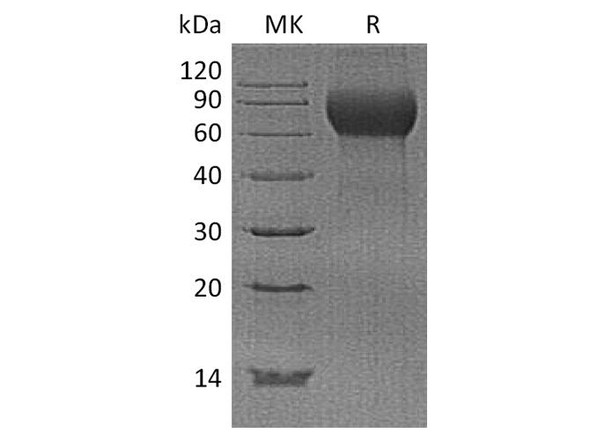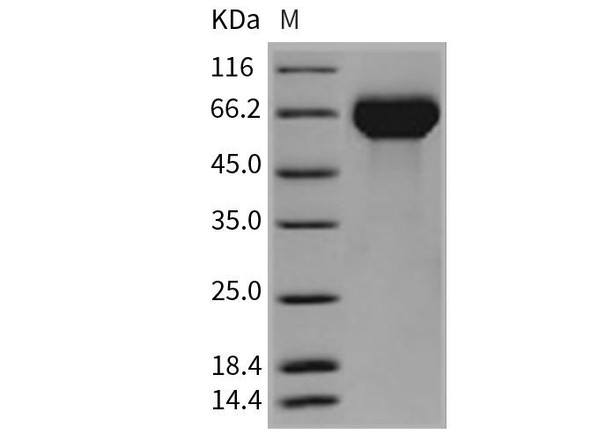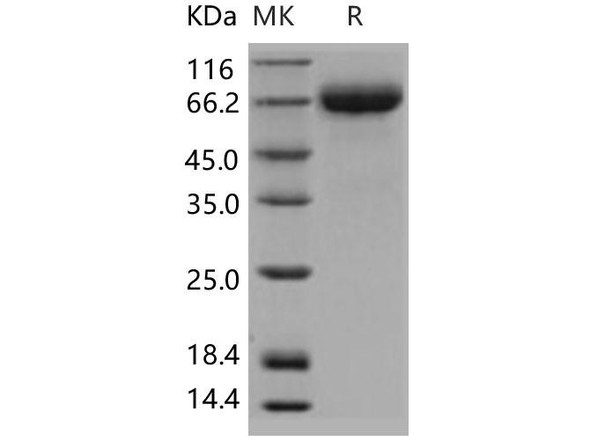Description
| Product Name: | Hemopexin Recombinant Protein |
| Product Code: | RPPB3838 |
| Size: | 50µg |
| Target: | Hemopexin |
| Synonyms: | Hemopexin, Beta-1B-glycoprotein, HPX, Haemopexin. |
| Source: | Human Plasma |
| Physical Appearance: | Sterile Filtered White lyophilized (freeze-dried) powder. |
| Formulation: | Lyophilized from (1.22mg/ml) solution containing 11.9mM phosphate buffer, 137mM NaCl and 2.7mM KCl, pH 7.4. |
| Solubility: | It is recommended to reconstitute the lyophilized Hemopexin in phosphate buffer, pH >7.0 containing 0.15M NaCl. |
| Stability: | Human Hemopexin although stable at room temperature for 2 weeks, should be stored at -20°C. |
| Purity: | Greater than 95.0%. |
Hemopexin (or haemopexin) is a plasma protein that binds heme with the highest affinity of any known protein. Hemopexin is generally expressed in liver, and belongs to acute phase reactants, the synthesis of which is induced after inflammation. Heme is potentially very toxic because of its ability to intercalate into lipid membrane and to generate hydroxyl radicals. Hemopexin�s function of scavenging the heme released or lost by the turnover of heme proteins such as hemoglobin defends the body from the oxidative damage that free heme can cause. Additionally, hemopexin discharges its bound ligand for internalisation upon interacting with a specific receptor located on the surface of liver cells. This hemopexin function is in order to preserve the body's iron. Hemopexin�s levels in the serum are an indication of how much heme is present in the blood. Low Hemopexin levels show that there is a lot of it in the serum. For that reason, low hemopexin levels indicate that there has been considerable degradation of heme containing compounds - mainly hemoglobin, it indicates hemolysis and low hemopexin levels are therefore one of the diagnostic features of a hemolytic anemia. It�s a Haem binding protein used in the assessment of intravascular haemolysis in conjunction with haptoglobin.
Human Hemopexin produced in Human plasma having a molecular mass of 70 kDa.
| UniProt Protein Function: | HPX: Binds heme and transports it to the liver for breakdown and iron recovery, after which the free hemopexin returns to the circulation. Belongs to the hemopexin family. |
| UniProt Protein Details: | Protein type:Secreted; Secreted, signal peptide Chromosomal Location of Human Ortholog: 11p15.5-p15.4 Cellular Component: extracellular space; extracellular region Molecular Function:protein binding; metal ion binding; heme transporter activity Biological Process: positive regulation of humoral immune response mediated by circulating immunoglobulin; receptor-mediated endocytosis; positive regulation of immunoglobulin production; heme transport; positive regulation of tyrosine phosphorylation of Stat1 protein; viral reproduction; hemoglobin metabolic process; cellular iron ion homeostasis; heme metabolic process |
| NCBI Summary: | This gene encodes a plasma glycoprotein that binds heme with high affinity. The encoded protein is an acute phase protein that transports heme from the plasma to the liver and may be involved in protecting cells from oxidative stress. [provided by RefSeq, Apr 2009] |
| UniProt Code: | P02790 |
| NCBI GenInfo Identifier: | 11321561 |
| NCBI Gene ID: | 3263 |
| NCBI Accession: | NP_000604 |
| UniProt Secondary Accession: | P02790,B2R957, |
| UniProt Related Accession: | P02790 |
| Molecular Weight: | 51.7 kDa (462aa) |
| NCBI Full Name: | hemopexin |
| NCBI Synonym Full Names: | hemopexin |
| NCBI Official Symbol: | HPX�� |
| NCBI Official Synonym Symbols: | HX�� |
| NCBI Protein Information: | hemopexin |
| UniProt Protein Name: | Hemopexin |
| UniProt Synonym Protein Names: | Beta-1B-glycoprotein |
| Protein Family: | Hemopexin |
| UniProt Gene Name: | HPX�� |
| UniProt Entry Name: | HEMO_HUMAN |






